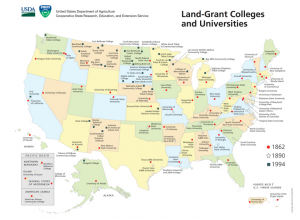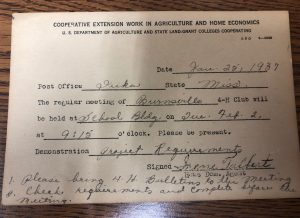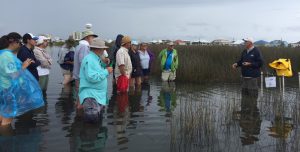
After 17 years as an Extension Agent, I still sometimes hesitate when someone asks what I do for a living. When I respond, “I’m a county Extension Agent,” I usually get one of two types of answers. The folks familiar with us will say, “Oh, cool! We use your office all the time!”, “you mean like Like Mr. Kimball in Green Acres?”, or “I was in 4-H as a kid!” and I breathe a sigh of relief because I don’t have to explain it. When I mention UF they assume I work for UWF, or just look at me quizzically and ask what “Extension Agent” means. If I don’t have much time or it’s just a formality, I’ll respond that I work in environmental education. But, if they’ve got time, the job has an interesting history that I love sharing.

In the middle of the Civil War, President Lincoln signed the Morrill Act (1862) into law. At the time, half of Americans lived in rural areas and 30% lived or worked on farms. University-level education was typically available only to the wealthy and at private colleges. This Act created a system of public colleges in every state—the federal government gave each state 30,000 acres per congressional district to build a “land grant” university focusing on agriculture and mechanics (what we’d call “engineering” today). Here in Florida, our land grant schools are the University of Florida and Florida A & M University, but you might recognize the other southern land grant schools that are well known for their agriculture, veterinary, and engineering programs—Auburn, Mississippi State, Texas A & M, etc. Over time, land grant status was extended to historically black colleges and universities (1890), Native American schools (1994), and other topic-based educational funding released for Sea Grant (1966), Space Grant (1988), and even Sun Grant (2003) programs.
In 1887, Congress called for the creation of agricultural experiment stations, which we now call “research and education centers” like UF Milton and the agriculture/turfgrass research station in Jay, Florida. These serve as satellite campuses and places to conduct pioneering research to improve crop productivity and test new technologies.

Finally, in 1914, the Smith-Lever Act created the Cooperative Extension Service, giving rise to my profession of “Extension Agent.” Instead of teaching new ideas and technology on a college campus, we are tasked with “extending” that knowledge out into our communities. In the early 1900’s this still focused on agriculture, along with “home demonstration” agents who taught farmers’ wives how to make the best of preserving food and maintaining a household. 4-H became an agricultural and leadership program for the kids. Extension workers helped millions of Americans survive the Depression and wartime years due to their shared expertise on raising one’s own food and increasing farm productivity.

From the earliest days of Extension, our mission has been to take highly technical information and distill it into a format that anyone can understand and use to their benefit. The “Extension Worker’s Code,” published in 1922, gave this timeless advice to Extension Agents setting out into their counties. “In lectures and demonstrations use familiar feeds, soils, plants, and animals as illustrations. Charts, lantern slides, motion picture films, and dried and preserved specimens may also be used effectively. No matter how much you may have to say or how important your subject, avoid lengthy, technical, or long winded discussions. Organize your material in such a way that you will be able to give the boiled-down, concentrated gist of the subject with just enough details to make yourself clearly understood.”

Those early programs in agriculture, family & consumer sciences, and 4-H are still strong within the Extension system. As more families moved away from rural areas (only 2% of Americans farm now) into the suburbs and cities, needs have changed. Extension has evolved with the times and broadened our expertise, including home horticulture, environmental and coastal issues, health and nutrition, energy use, and community development. We teach in a classroom format sometimes (and these days via Zoom, video, Facebook Live or other online technology), but an effective Extension Agent is generally going to be out where people need their help or want to learn–in their backyard, in a field with their livestock or crops, facilitating a community meeting, leading hikes, or running day camps.

In Florida, every county has an Extension office. The number of agents (aka “county faculty” to UF) and type of expertise in offices depends highly on county population and local funding. Most Extension offices are also county departments (or housed within one), and the “cooperative” part of Extension is still in play as we are both University and county employees.
Of course, the internet has made information more accessible to everyone than it was 100 years ago. The difference is, you can call an Extension Agent and talk to an actual human, with real-life experience that will be relevant to your situation. We will also guarantee that what we tell you is based in research and fact. So, next time you have a question about plants—identifying them or figuring out how to garden or landscape—raising a backyard chicken, preserving water quality, finding places to hike or paddle, how to prepare for a hurricane, cook a nutritious meal, or teach a young person how to lead others, give us a call. Your County Extension Agents would be happy to help.
 1
1
